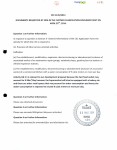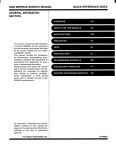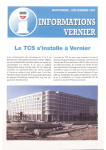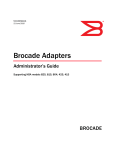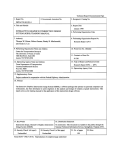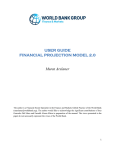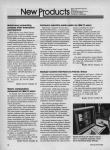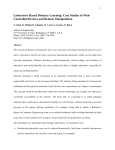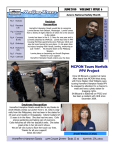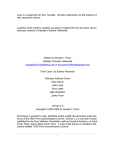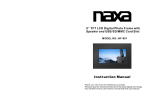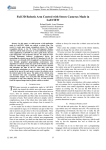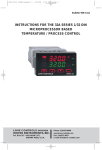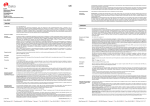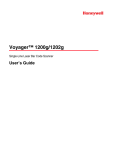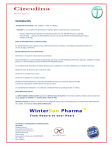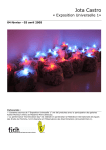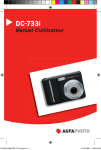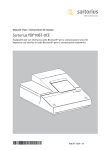Download 08. Response to Clarification Letter
Transcript
lq_stct'ves NP House, National Drive, Sea Lots, Port of Spain, Trinidad, W.I. TRINIDAD & TOBAGO NATIONAL PETROLEUM MARKETING COMPANY LIMITED T: (868) 625-1364 F: (868) 627-4028 W: www.np.co.tt June 06, 2014 Manager of Technical Services The Environmental Management Authority, #8 Elizabeth Street, St. Clair, PORT OF SPAIN. Attention: Mr. W. Rajkumar, Dear Sir, RE: NPMC STARLITE, DIEGO MARTIN: CEC REFERENCE NO. CEC3725/2012. We refer to the meeting held on 2014 May 29, CEC reference no. CEC3725/2012. The team of EMA officials present at the site visit requested further clarification on information that was supplied for the above mentioned CEC. We have enclosed with this letter the requested information: 1. The detailed CNG information 2. Flyer 3. Signatures from relative stakeholders. Thank you for your positive response. Yours faithfully, For: TRINIDAD & TOBAGO NATIONAL PETROLEUM MARKETING COMPANY LIMITED REINED 09 JUL g114 `EMA 1,14. Wazeer Aleem Manager, Capital Projects Unit DIRECTORS: Neil Gosine (Chairman). Carla Scipio, Ranjit Ramnarine. Kerry Rampersad, Nigel Darwent, Rabindranath Lackhan, Kenneth Samlal, Brendon Gray. Keith Narayansingh, Mark Alfonso, Amreeka Maharaj 08/07/2014 RESPONSE TO FURTHER CLARIFICATION ON CEC 3725/2012 1. With reference to question one (1) on the request for further clarification the installation on compressed natural gas (CNG) infrastructure and associated pipelines will form a part of the scope of works for this CEC 3725/2012 Application. Please see APPENDIX 1 for a revised description of the scope of works and a revised project schedule for the proposed development. 2. Regarding the area of the development - The correct figure should read 2226.2 m2 and not 2181.66 m2 as represented on the "Emergency Evacuation Route" layout drawing (#5147 — 02). 3. Please see APPENDIX 2 for the amended drawing including the components that was requested in the request for further clarification document. 4. With reference to question four (4) on the request for further clarification please see APPENDIX 3 for the information requested in 4(i), 4(ii) and 4(iii) 5. Regarding EMA's stated lack of data for groundwater at 8 of 10 monitored points - Please note that the Authority has typically required of the Company, for similar sites, that two (2) groundwater monitoring wells be set up on site to get an indication of the quality of groundwater entering the site and leaving the site. The two (2) wells are maintained so that additional samples can be retrieved over time (as is mandated by the CEC for the site). Additional core samples for groundwater are not necessary under these conditions as the two (2) wells are deemed adequate Regarding the missing Permissible limits values and scale for Soil & Groundwater clean-up levels Contaminant CLEAN UP TARGET LEVELS Soil (mg/kg or ppm) Groundwater (ug/L or ppb) Total Recoverable Petroleum Hydrocarbons 340 5000 Benzene Toluene 1.1 1 380 40 1100 30 Ethylbenzene Total Xylene 5900 20 Methyl Tertiary Butyl Ether 3200 50 40 20 Naphthalene 6. With reference to question six (6) on the request for further clarification please see APPENDIX 4 for the flyer and relevant signatures. • • APPENDIX 1 • • REVISED SCOPE OF WORKS AND PROJECT SCHEDULE Tnnalad • Tobago Nabonal Petroleum Markebng Company Landed NPMC STARLITE CONSTRUCTION SCHEDULE ID 0 1 -- 4 s I Task Name CIVIL WORKS Duraton predecessor, 79 days Mobilsabon 7 days Hoarding 7 days 3 67 dal,. Selbng ON 8 Peng 6 days 6 days 7 n l Fabowbon of Rentorwment and Formwork Placement of runforcernent Pile cap 42 17 Cast Pilecap up to underside of Ord Beams 13 WI Install Services in loundabon. Electrical and Plumbing 6 days 11 3 days 12 Backfill excavated areas to underside of Ord. Beams 2 days 13 Ground Beam Formwork Placement of reinforcement Ord. Beam. Slab and Columns 4 days 14 15 Is IU 11 I_S Cast !nada Ground loor slat, IS IS n Placement of Column reinforcement 2 days 17 Column Formwork 3 days 18 IQ Cast Insdu Columns D 20 21 'Ti 22 NS 23 ' 24 25 28 V 28 29 3lY– 31 32 a To 36 37 38 9 40 41 2 43 4 days 22 Roof Construction 2 days 23 Install all Underground Services Plumbing, Money Shoot and Electrical 7 days Backfill Al Trenches 2 days 32 Install Street Born. Oversoll Manholes and Monaoring Walls Cast 'multi Tank Fern, Slab 50 Install Crash Barriers and Pump Island Forms 5 days 49 51 Cast Iniatu Pump Wanda 7 days 50 Install Dispensers Induct ng lowing 8 days 51 instal Compressor and Po Gauge 7 days 52 lawd Condurts Underground Tanks and Dispensers NOM Sub Panel Pump Controllers Vemler-Root MI Wire Submersible pumps Dispensers and Veeder Root Leak Detection system nstall Purlins 2 days 59 nstall SoiN Panels 4 days 60 stall Fascia 4 days 61 NA Lighting to Include LED Red Band 4 days 62 T&TEC connection 2 days WASH connection 2 days 69 TST7 connection 2 days 70 • th—v, ..4....--v vir, w_ 11 days 68 Ministry of Energy inspecton 1 day 1 day 74 1 day 75 1 clay 76 Precomissaning test with MOE General clean-up, touchwia• 2 days 77 Minor remedial WONG 3 days 78 80 Handymen Drew Martin Regional Corporator, Completion Cerbficala 2 days 79 81 Inspections Completed 0 days 80 r day Handover to Marketing Hambyn p100,C1 i preparations for opening (coordination) Task • 17iC7 GS 1 day 73 PROJECT HANDOVER f CLOSURE Project ConsauctIon Schedule 41 3_'_i 1 day 71 Utlity Connection Completed OSHA inspecton Fire inspection 83 84 ' —4, " – 2 days 66 75 82 . 21T- - - - -• - - • - 7 days 64 UllUTYCONNECTIONS 74 6 -4. . 7 days INSPECTIONS 79 vw.---2,,,, S days 65 stall Pylon Sign natal al Categoh Signs 71 z. 14 days SIMS nada Canopy Lighted Noce and Moving Graphics 69 –"l • 1 day SIGNAGE 68 r 7 days 56 'Ls 6 – 15 days 54 CANOPY 60 6 lkl--..e ' 10 days 4 days 55 NI n stall Canopy Main Frame BB li- — 21 days 4555025 days FUEL SYSTEM- ELECTRICAL 1 LEAN DETECTION fly 83 - _.,. 7 days 48 59 61 7--.. 59 days 7 days 45SS 2 days 37 21 days 38 2 days 41PS-2 days 21 days 39FF 2 days 4151FF 2 days 42 4 days 43 60 days 3ISS 49 10 . 10 days 34 48 57 ..._, ]drys 33 Place compact and prepare subbase In . 5 days 5 days 25SS•3 days 5 days 3 days 27 3 days 26 days 650 14 days 55 . S days 6 Plumbing Execution of Plumbing Works Electrical Works Installaton and Wiring PI Bulaing's Plechical System Air Condition Installaton of Ar Condition Unds Forecourt Works 10 days 47 54 • 7l-77–l---J—i 1 clay 21 Cast Insau Swpended Beams and Hat Floor Slab 10 days 46 52 1 eek 15 4 days 20 Suspended Beams and Fast Floor Slab Formwork Eilccirwork Backfill all trenches 01 iWtt 13 1 day 19 Install %raglan vent Pining 48 (Week 11 1 day 16 CND EQUIPMENT Construction Cl concrete bate for CNG equipment Installation of CND compressor and Cascade storage cylinders Instalaton of gas supply line from NGC's metering station and high pressure dii Third Parryng of lines Electrical installation of CNG control panel compressor motor and clisPenaer Construction of island forms Installas on of CNG Dispenser Installat on of Protection bollards for CND Equipment MECHANICAL WORKS 45 I eek 9 4 days 15 Cast Matti Concrete Forecourt Pavement IS -- 2 days 9 2 days 10 VG ie I sek 7 IWSeKS 14 days 8 Pile cap formwork 11 14 IWeekJ I.Yaleek 1 7 days 4 Dernolton Budding Works 7 0 'Week-2 21 days Preliminary Works 6 to Week-4 arta/07 0 days 83 Split Progress Hlwbns ♦ Sum ....... Prq*CSUmmryc.iiiiii External Tasks 1 1 Euftsnui OA W Nedra APPENDIX 2 PROPOSED SITE PLAN WITH REQUESTED DETAILS SHOWING • • PROPOSED DRAINAGE AND CNG DETAILS 1 SITE LAYOUT MAP TOO LARGE TO BE SCANNED. THE MAP CAN BE FOUND IN THE NATIONAL REGISTER AT THE ENVIRONMENTAL MANAGEMENT AUTHORITY'S HEAD OFFICE LIBRARY AT ELIZABETH STREET ST. CLAIR. APPENDIX 3 CONCEPTUAL EMERGENCY RESPONSE PLAN AND CNG SAFETY DETAILS • Starlite Service Station - Emergency Response Plan I 2014 Starlite Service Station • Emergency Response Plan 2014 • Starlite Service Station - Emergency Response Plan 12014 • Starlite Service Station Project Emergency Response Plan June 2014 Trinidad and Tobago National Petroleum Marketing Company NP House National Drive, Sea Lots, POS. • Tel: 1-868-625-1364 EXT 260 CAPITAL PROJECTS MANAGER: DATE: 0SA014?-c- Created February 2014 Coc- jt, Starlite Service Station - Emergency Response Plan 2014 Policy & Purpose Policy In the event of an emergency, we will be prepared to protect the health & safety of all. This plan was established to systematically combat emergencies and all employees, contractors and visitors are expected to know and follow procedures outlined in this plan. Purpose The purpose of the Emergency Response Plan is to minimize the danger to life and property in the event of an emergency. To achieve this goal, we have outlined welldefined, simple steps to be taken should an emergency occur. For the purpose of this plan, emergency procedures shall be implemented for: Fires, Explosions, Bomb threats, Hazardous material spills Natural disasters: a. Floods; b. Earthquakes; c. Hurricanes and Tropical Storms. These may require immediate emergency action and / or evacuation of the facilities. There shall be a minimum of at least one fire drill every four months, totaling three per year. This Emergency Response Plan Is Applicable To The Following: 1. All NP employees (both permanent and temporary) working at NP'S Starlite Service Station's facility at Lot #18 Four Roads, Diego Martin. 2. All contractors working or visiting NP'S Starlite Service Station's facility; and 3. All visitors to the NP'S Starlite Service Station's facility. Key Priorities The key priorities in any emergency response are to: 1. Protect the safety and health of all persons involved or affected; 2. Minimize the impact on the environment; 3. Minimize the impact on property and assets; 4. Protect continuity of operations; 5. Protect current and future business opportunities; and 6. Maintain and where possible, improve the image and reputation of NPMC. Starlite Service Station - Emergency Response Plan 2014 Organization For Emergencies In a potential or real emergency situation, any member of staff or contractor on the scene or near the incident site should first do what is indicated by the circumstances, e.g.: • Sound the klaxon/horn and/or raise a verbal alarm to immediately alert personnel; • • Contractor employees involved will shut off all cutting set„ turn off all equipment and engines before evacuating, providing worker safety is not jeopardized by doing so. Where equipment could not be switch off, the fire department or other responding emergency agency will be notified of the presence and location of this hazard upon their arrival. If fire is small (waste bucket size), use the nearest portable fire extinguisher; • If the fire is large, close all office doors to area to prevent the fire from spreading; • Assist as directed by the respective Manager / Supervisor; and • Evacuate the compound. • The Security Department will immediately implement the Emergency Response System (E.R.S), i.e.: 1. Contact the Project Manager, Captial Projects Manager, H.S.E Officer/Assistant, and the Security Officer; 2. Keep the main exit gate open and unobstructed by unnecessary persons or vehicles throughout evacuation procedures As an incident escalates, it may become necessary to activate the Starlite Service Station's Crisis Management Team to manage the emergency response. The Crisis Management Team comprises the members of the Capital Projects Department and other personnel as follows: 1. NPMC HSE Manager — • Kevon Samaroo 1-868-625-1364 ext 260 or 1-868-759-7467 2. NPMC HSE Officers 3. NPMC Environmental Co ordinators 4. NPMC Capital Projects Manager 5. NPMC Project Officer Starlite Service Station - Emergency Response Plan () Emergency Response Guidelines for None Working Days and Public Holidays: • Ensure that the building is evacuated and that all occupants including visitors have been accounted for; • Notify senior management; • Undertake First Responder emergency action if possible; • Request assistance from emergency responders such as Trinidad & Tobago Fire Services, Emergency Health Services, Trinidad & Tobago Police Service, Office of Disaster Preparedness and Management (ODPM), • Prepare to facilitate the Fire Service and any other responding agencies. Emergency Response Procedures - General Evacuation On the Starlite Service Station's Project, minor hoarding works are the scope of works being conducted at this time and as such NPMC has prepared an emergency evacuation for just one area. Once the klaxon/horn is sounded or an evacuation has been ordered, the Crisis Management Team immediately initiates this Emergency Response Plan and any associated policies and procedures. 1. Crisis Management Team members escort all their personnel to the designated assembly areas in an orderly fashion: • Ground evacuation procedures are as follows :- One muster point will be established. This muster point is will be clearly marked by a green and white "Muster Point" sign attached to a utility pole. At the sound of a klaxon/horn all workers will down all tools and proceed to the main gate in an orderly fashion. The security guard stationed at the main gate will stop all traffic and direct the workers to proceed to the muster point. There all relevant safety representatives will do a head count to account for every worker. 2. Crisis Management Team members make a visual sweep of their respective areas for missing personnel, exit the compound and proceed to the designated Muster Point for a head count; 3. A head count is taken and verified. Any missing persons will be immediately reported to the NPMC; 4. Injured persons are attended to until emergency personnel arrive; 5. At the end of the evacuation, Crisis Management Team members to escort employees into the compound upon receiving authorization from emergency personnel. Starlite Service Station - Emergency Response Plan 2014 Bomb Threat, Fire, First Aid, Spill, and Natural Disasters Procedure 1. As outlined in NPMC Francise Model Manual Procedure. • • Starlite Service Station - Emergency Response Plan j 2014 Roles and Responsibilities of Key Personnel HSE Manager (or Alternate) The Crisis Management Team is headed by the NPMC HSE Manager and/or the Capital Project Manager. Emergency duties • Reporting to the Emergency Operations Centre; • Receiving briefs from the stand-in HSE Officers; • Assuming and announcing overall command; • Confirming the nature of the emergency; • Activating the Emergency Operations Centre as necessary; • Managing response activities to ensure effective performance of all parties; • Confirming the welfare of staff (including those, who require initial first aid treatment and any further necessary medical care for the injured); • Directing activities to properly protect human life and the environment, and to keep the situation from escalating; — Activities include evacuation, search and rescue, first responder fire fighting, safety of personnel and equipment, request for first aid • Ensuring timely liaison with and involvement of other occupiers, required personnel, clients and governmental authorities; • Managing media/press and public relations; and • Determining when to stand down the emergency and sounding of the "All Clear". Starlite Service Station - Emergency Response Plan , 2014 Post-Emergency duties • Arranging debriefing, post emergency survey; post emergency investigations, completion of required reports, post mortem critique. Pre -Emergency duties • Ensuring a current Emergency Response Plan Manual; • Developing the plan to include emergency procedures, evacuation routes, and emergency personnel roster; • Ensuring the availability of all fire and emergency equipment is in a state of readiness at all times; • Providing employees with detailed information regarding the Emergency Response Plan; • Ensuring training activities for adequate performance of duties during an emergency; • Ensuring knowledge and location of Assembly Points, emergency exits and related routes used for evacuation process; • Ensuring identification and location of any physically challenged person(s) who will require special assistance during emergencies; • Liaising with and involvement of upper management, contractors and external organizations as necessary; • Maintaining plan current with changes in facilities, emergency wardens and personnel. (Plan is to be reviewed whenever changes occur, after any major incident and certainly at least annually); • Ensuring that management is provided with current copies of this Plan; • Following up on the appointing of emergency wardens; • Ensuring availability of emergency response equipment and supplies; • Conducting hazard identification/risk assessments to ensure appropriate control measures; and • Answering any questions regarding this plan or providing further information or explanation of individual duties under the plan; Starlite Service Station - Emergency Response Plan 12014 Emergency duties • Undertaking initial assessment; • Directing emergency activities; • Determining required response actions; • Arranging for any medical treatment for the injures as necessary; • Providing for assistance to disabled or impaired employees; • Ensuring that the Contractor Safety Representative takes)a head-count of their employees in event of evacuation, which is then reporting to the HSE Manager; • Alerting the HSE Manager of the occurrence; • Keeping the Crisis Management Team informed of developments, actions taken, number of persons involved, estimate of casualties, type of assistance needed, etc; and • • Implementing strategies of the HSE Manager. Starlite Service Station - Emergency Response Plan 1 2014 Training • The H.S.E Department will ensure that all new employees are informed of the Emergency Response Plan for Starlite Service Stations Project and his/ her responsibilities under said plan, prior to commencing his/ her work assignment; • The Main Contractor will arrange delivery of training for Emergency Wardens First Aiders in their responsibilities. • The HSE Officer/Assistant will arrange for facility or departmental evacuation drills at least annually. Emergency Coordinators and members of the Emergency Team shall familiarize themselves with all means of escape from the compound, and the designated assembly areas. The Emergency Team shall be trained to attempt to control small, incipient fires only - those which are localized in a contained area and which are in their initial stages. Emergency Team members are NOT to attempt to fight any fire which is out of control and has spread to become a large or major fire. • Fire extinguisher use; • Location of fire extinguishers; • Types of fires to attempt to control; • Notification procedures; • Shall become familiar with the location and use of Material Safety Data Sheets (MSDS); • Shall know how to control a chemical spill that does not require the use of a respirator; • Shall be trained and familiar with notification procedures; Page 10 of 15 Starlite Service Station - Emergency Response Plan (2014 Neighbours The compound is surrounded by Starlite Shopping plaza, GAK Electrical and other residences. Neighbours are advised by telephone when Fire Drills are about to be performed. The NPMC HSE Team will communicate with the surrounding neighbours via telephone as per listing below. If required, base on the emergency situation, visits would be made to each neighbour by the HSE Team members. The neighbors would be informed about the nature of the emergency, • the level of risk and how it could impact their facilities. The site will also be equipped with audible alarms should incase an emergency situation arises. This will also be heard by neighbouring organzations and they will be instructed by our HSE Team as well as the assistance of the Trinidad and Tobago Fire Services and Trinidad and Tobago Police Services to initiate their emergency evacuation plan and assemble at their designated muster point locations depending on the nature of the emergency situation. • Emergency Telephone Numbers for Neighbours NAME JCA OPTICAL SCOTIA BANK BMOBILE DIGICEL RITUALS HILO ROYAL BANK FOUR ROADS POLICE STATION GAK ELECTRICAL RIDGEWOOD TOWERS PHONE NUMBER 632-3937 62-SCOTIA 633-2101 633-7516 225-5109 637-9769 625-7288 637-3860 632-4881 632-7836 Starlite Service Station - Emergency Response Plan 1 2014 Security Guard on Duty All security guards shall be trained in emergency procedures. The HSE Manager shall come immediately to the compound and assist the security guards with evacuation as necessary. Security guards on duty are responsible for manning their posts at the main exit to ensure rapid, efficient flow of personnel out of the premises and efficient entry of emergency response personnel (such as the Fire Services) into the compound as needed. A security guard on duty shall be designated after the evacuation process is performed to aid in the head count with the assistance of the Daily Attendance Register ensuring that all persons on the compound and who would have taken up duties are accounted for. • Starlite Service Station - Emergency Response Plani2014 Medical Services Contractor Safety representatives will provide the main contractor Safety Representative with a list of all first aiders in their workforce, a copy of same must be submitted to the NPMC representative together with a copy of their first Aid Certification. Each Contractor MUST have at their Safety Representative's disposal a properly outfitted first aid kit on site AT ALL TIMES. In the event of a major medical emergency during normal working hours, the Trinidad & Tobago Ambulance Service shall be notified immediately. While waiting for the Trinidad & Tobago Ambulance Service to arrive, first aid responders shall attend to all injured personnel and turn over those duties to the Trinidad & Tobago Ambulance Service on arrival. • Starlite Service Station - Emergency Response Plan 12014 Procedures for Earthquakes In the event of an earthquake the following steps should be taken: Protect your head and face from being hit by falling objects. Get under a solid structure. Stay away from glass windows, mirrors and any heavy object. Do not rush to exit the compound, stand in a strong doorway or structure. If outside in the yard / building, move into the open area away from scaffoldings, heavy • equipment, overhead lines, etc. After an earthquake, take the following steps: • Contact the HSE Representative. • Check for fires. • Check for injured and contact a first aid responder. All Contractor supervisor/foremen/Safety Representatives will check their surroundings for any serious damage and immediately report them to their Emergency Coordinator or Project Manager. • In the event of evacuation, all personnel shall report to the designated assembly areas and await further instructions. Page 14 of 15 Starlite Service Station - Emergency Response Plan 12014 Emergency Telephone Number Government Agencies Telephone Numbers • 990 Trinidad & Tobago Fire Services (Diego Martin) 637-9222 Trinidad & Tobago Ambulance Services (EHS) 623-4343 / 640-4343 990 Trinidad & Tobago Police Service (Diego Martin) 637-3860 Mount Hope Hospital (All Departments) 645-4673 / 645-2640 Port of Spain Hospital (All Departments) 623-2951 Emergency Health Services 811 Environmental Management Authority 628-8042/44/45 National Emergency Management Agency (NEMA) 623-2079/ 8004 Water & Sewerage Authority (St. Joseph) 645-8573 Trinidad & Tobago Electricity Commission 643-1974 ODPM 511 ea END Page 15 of 15 999 Trinidad & Tobago National Petroleum Marketing Company Limited EXTRACTED FROM FRANCHISE MODEL MANUAL EMERGENCY SITUATIONS, HEALTH, SAFETY, SECURITY AND THE ENVIRONMENT 9.1 EMERGENCY SITUATIONS 9.1.1 Robberies at Service Stations 9.1.1.1 During A Robbery 9.1.1.1.1 During a robbery it is important to stay as safe as possible by staying calm, and giving the robber what he asks for. Do not try and prevent the robbery, stop or chase the robber or confront him in any way. Your primary role in the situation is to keep yourself and others as safe as possible. 9.1.1.1.2 As soon after the incident as possible, write down a description of the robber or robbers and everything that happened. Look for distinguishing characteristics that will assist in identifying the criminal. 9.1.1.1.3 As much as possible try and protect the crime scene by not touching areas that the robber might have touched. 9.1.1.1.4 Keep the store locked and discontinue serving customers until the police have concluded their investigation and left the premises. Do not estimate the amount of loss to the police; your Franchisee will provide the necessary information after a cash audit has been completed. 9.1.1.1.5 Do not talk to anyone, including regular customers, about the robber. Refer any media inquiries to Franchisee. 9.1.1.1.6 Perform an end of day report to determine the size of the loss. Trinidad & Tobago National Petroleum Marketing Company Limited EXTRACTED FROM FRANCHISE MODEL MANUAL 9.2. Accidents/Injuries/Illnesses 9.2.1. Call the Ambulance or emergency operator and provide them with all the information they request, including: i. Your store address and phone number ii. Your full name iii. The name(s) of any injured person(s) 9.2.2 Stay on the line, be patient, and give the person answering your call a chance to respond to you. If you are asked to wait, stay on the telephone and be patient. 9.2.3 After contacting the appropriate authorities, notify NP's Security Department immediately of any accident or injury requiring medical attention. Next, contact the Area Manager responsible for the site. Telephone numbers used for this process are: NP Security Department: 625-1920 Ext 516/517 Trinidad & Tobago National Petroleum Marketing Company Limited EXTRACTED FROM FRANCHISE MODEL MANUAL 9.3 Incidents of Violence 9.3.1 Misconduct/Violence by an Associate 9.3.1.1 NP does not condone any form of misbehaviour or violence in the workplace. An Associate may be disciplined or terminated if he or she poses a threat of violence in the workplace. Any associate who makes an outright statement of a desire to harm others, or who makes threats or demonstrates significant problems with controlling anger, may be terminated. 9.3.1.2 Weapons are absolutely forbidden in the workplace. Any associate aware of the presence of a weapon at their workplace should contact the Police. 9.4 Misconduct by Others To prevent injuries resulting from violence, follow these procedures: 9.4.1 Follow robbery and violence prevention procedures. 9.4.2 If you suspect a weapon, do not attempt to detain customers suspected of shoplifting. 9.4.3 Do not get into arguments or exchange insults with customers, regardless of the provocation. 9.4.4 Stay calm and remain polite. 9.4.5 If physically threatened, avoid direct physical confrontation and call the police. Trinidad & Tobago National Petroleum Marketing Company Limited EXTRACTED FROM FRANCHISE MODEL MANUAL 9.4 Incidents of Violence (Cont'd) Fights If a fight occurs on Company property, NP's primary concern is for the safety of its store personnel and customers. Do not become involved in the fight, either 9.4.6 physically or verbally. Do not threaten the parties who are fighting. Such 9.4.7 threats may increase the likelihood of your becoming involved. Call the Police immediately. Do not wait to see if 9.4.8 fight stops. It is the duty of the Police to stop the the fight and to provide any necessary protection. the police that there is a fight in the store, Advise and give them the store name, phone number and address. Trinidad & Tobago National Petroleum Marketing Company Limited EXTRACTED FROM FRANCHISE MODEL MANUAL 9.4 Incidents of Violence (Cont'd) 9.4.9 Extortion Situations Extortion is the use of physical threat to force a person to comply with the extortionist's wishes. Extortion efforts directed at NP Stores' Associates may take the following form: If threats are received via phone calls or in person, contact the police. If an associate receives a call such as described above, the associate should take the following action: 9.4.9.1 Tell the caller you will comply with his demands; 9.4.9.2 Call the police, inform them of the call, and request that a patrol come to the store. Call the NP Security and request that an officer be dispatched to the site. 9.4.1.3 DO NOT COMPLY WITH THE CALLER'S DEMANDS; 9.4.1.3 The most important consideration in this type of circumstance is to ensure the safety of sales associates and customers. Trinidad & Tobago National Petroleum Marketing Company Limited EXTRACTED FROM FRANCHISE MODEL MANUAL 9.5 Robberies, Break-Ins, Assaults and Vandalism In the event of a robbery, for your safety and the safety of others the following procedures should be followed: 9.5.1 Keep it short and smooth, like a normal sales transaction; 9.5.2 The average robbery takes less than two minutes. Obey the robber's commands; your co-operation can reduce the threat of violence; Try to keep calm and observe the actions of the robber. Do not stare at the robber. Try to remember exactly what is said, what he/she looks like, and his/her means of transportation. 9.5.3 9.5.4 9.5.5 Avoid surprises or any action that might anger the robber or make him/her nervous. Warn the robber of any other associates working in the store, or about any possible urprises such as a customer pulling into the parking lot. If you should move, let the robber know what to expect; Don't argue with the robber; 9.5.6 Give the robber what he/she asks for. Do not argue; do not resist the robber. 9.5.7 After the robber has left the store, lock the store doors, And call the police immediately; 9.5.8 Take the necessary steps to determine loses and inform 9.5.9 9.5.10 your Franchisee. Re-open the store when all necessary investigative steps have been taken. Do not talk to anyone, including regular customers, about the robbery. Trinidad & Tobago National Petroleum Marketing Company Limited EXTRACTED FROM FRANCHISE MODEL MANUAL 9.6 Dangerous Weather In case of a hurricane, all stores will provide service up to the last minute possible, without endangering personnel or our customers. Service to customers will be resumed immediately after all danger to personnel has passed. The Franchisee and Area Manger will be in communication during any "Hurricane Watch" or "Hurricane Warning". He/she will advise when to close the store. 9.6.1 Things To Do In The Event of a Hurricane 9.6.1.1 Prepare store for a hurricane by securely packing away any loose merchandise and store equipment. 9.6.1.2 Continue to serve your customer efficiently and calmly; Trinidad & Tobago National Petroleum Marketing Company Limited EXTRACTED FROM FRANCHISE MODEL MANUAL 9.7 Things To Do Before Leaving Your Store 9.7.1 Close store as you normally would, putting away cash, 9.7.2 Place any remaining empty cases in cooler; 9.7.3 Store all remaining merchandise inside store; 9.7.4 Store cash register in back room (off the floor); 9.7.5 Be sure back room door is closed tightly & locked; 9.7.6 Miscellaneous outside signs must be placed inside the store. Things To Do After a Storm 9.7.7 • Phone your Manager to report any damage, shortage, or loss of power; 9.7.8 Resume normal work schedule. REMEMBER THAT IN THE EVENT OF A HURRICANE, OUR CUSTOMERS WILL BE DEPENDING UPON US SO LET US DO OUR BEST TO FULFIL THEIR NEEDS • Trinidad & Tobago National Petroleum Marketing Company Limited EXTRACTED FROM FRANCHISE MODEL MANUAL 9.8 Power Failure 9.8.1 Close Store. 9.8.2 Check if power failure is isolated to the store by checking neighbouring buildings. 9.8.3 If trouble is within your store. Check the electrical panel for a blown fuse or a breaker that has tripped; 9.8.4 If the electricity is out throughout the neighbourhood, contact T&TEC; 9.8.5 Always ensure that there is a working flashlight at all times; 9.8.6 Do not open the cooler doors, ice cream freezers, or refrigerators, until the electrical service is restored; 9.8.7 If you are without electricity for more than 15 minutes, notify your Manager. In addition, make arrangements to secure perishable items (e.g. ice cream, milk) so that merchandise can be moved in order to prevent spoilage. 9.9 Fires 9.9.1 All personnel are expected to know the location of fire extinguishers and how to use them; 9.9.2 If a fire breaks out in the store, and it is safe to do so, the Associate on duty should attempt to put out the fire with the dry chemical extinguisher available in the store; 9.9.3 If a fire breaks out in the store, evacuate all customers and do not permit any additional customers to enter. Do not lock the doors to the store; 9.9.4 Keep emergency numbers posted nearby (Fire Services, Ambulance, Emergency Health Services-EHS the nearest Regional Health Authority). :—) Trinidad & Tobago National Petroleum Marketing Company Limited EXTRACTED FROM FRANCHISE MODEL MANUAL 9.9 Fires ( continued) Electrical Fires 9.9.5 If the cause of the fire is electrical, Do not attempt to put it out with water; 9.9.6 If there is safe access, turn off the power to the store. Call the fire department immediately, regardless of whether the fire has been put out. Then call your Area Manager; 9.9.7 All associates should evacuate the building and wait for the arrival of the fire fighters; • 9.9.8 Do not resume store operations until the fire fighting personnel have given clearance; 9.9.9 If there is extensive damage to merchandise, contact your insurers so that a proper assessment can be conducted. • Trinidad & Tobago National Petroleum Marketing Company Limited EXTRACTED FROM FRANCHISE MODEL MANUAL 10.0 ROBBERY PREVENTION This policy applies to all personnel involved with the handling of cash. Strict compliance with this policy reduces the possibility of stores being robbed and, more importantly, enhances your safety in the event of a robbery. Experience has proven that well-trained store personnel who consistently follow these prevention steps can greatly reduce the threat of robbery. 10.1 Cash Control The greatest influencing factor in robbery prevention is the amount of cash immediately available. 10.1.1 No MORE THAN $300.00 IS TO BE HELD BY FORECOURT ATTENDANTS AT ANY TIME. No MORE THAN $500.00 IS TO BE LEFT IN THE CASH REGISTER AT ANY TIME. Any amount in excess of this limit should be deposited into the drop safe. Cash-level violations may result in disciplinary action up to and including termination. 10.1.2 Ask customers for exact change or to pay with the smallest bills they have. ALL CASH SHOULD EITHER BE IN THE CASH REGISTER DRAWER OR IN A LOCKED SAFE. Trinidad & Tobago National Petroleum Marketing Company Limited EXTRACTED FROM FRANCHISE MODEL MANUAL 10.2 CIT Pick Up 10.2.1 The station's vault is to be opened in the presence of the security officer and two service station employees e.g. station manager and supervisor or supervisor and c-store associate. 10.2.2 All packets in vault must include safe drop slips reflecting the contents of the packet. 10.2.3 All packets in vault must be colour coded to reflect the shift on which the money was deposited. 10.2.4 The security officer must verify the number of packets being placed in the deposit bags. • 10.2.5 No more than thirty packets must be placed in a deposit bag. 10.2.5 After the packets are counted and placed in the respective deposit bags i.e. one deposit bag per shift the CIT provider must then check vault in the presence of station employees to ensure that all packets have been removed and placed in the respective deposit bags before bags are sealed. 10.2.6 Information on deposit slips must be written on deposit bags reflecting the following information> Station Name > To Delivery Address > Date Of Collection > Number Of Packets > Amount Said To Contain • Trinidad & Tobago National Petroleum Marketing Company Limited EXTRACTED FROM FRANCHISE MODEL MANUAL 10.3 Robbery Prevention Techniques 10.3.1 The store, driveway and parking areas should be kept neat and clean at all times, and well lit during evening and early morning hours. 10.3.2 Keep active. Your activity will turn away some robbers simply because it indicates that someone is in the store cares. 10.3.3 Be aware of activities outside the store. If you observe suspicious persons or vehicles, call the police before something happens. Ask for a routine patrol to check out "suspicious" person(s) or vehicles. Get the complaint officer's name. The police welcome such calls, and they often pay off in preventing robberies. 10.3.4 Maximise visibility by moving displays or signs that block the view of the register from the outside. 10.3.5 Make sure that you can see out and that police or passers-by can see in. 10.3.6 THE REAR DOOR SHOULD REMAIN LOCKED AT ALL TIMES. 10.3.7 Acknowledge each customer when he/she enters the store; make eye contact and greet the customer. 10.3.8 Spend time on the sales floor whenever you can. 10.3.9 Trash should be taken out only during daylight hours. 10.3.10 Post police, fire, utility companies, ambulance, NP and other emergency phone numbers near the phone. 10.3.11 No unauthorised persons are allowed behind the counter. Trinidad & Tobago National Petroleum Marketing Company Limited EXTRACTED FROM FRANCHISE MODEL MANUAL 10.4 Conduct during Investigations 10.4.1 Associates should co-operate fully with law enforcement officers conducting investigations of incidents on store property. 10.4.2 Associates should comply with all reasonable requests from law enforcement officers and avoid any confrontation or arguments. If an associate has a question about a law enforcement officer's actions, he/she should report the matter to the Manager. Trinidad & Tobago National Petroleum Marketing Company Limited EXTRACTED FROM FRANCHISE MODEL MANUAL 11.0 OTHER SECURITY AND SAFETY ISSUES 11.1 Weapons 11.1.1 IT IS A DIRECT VIOLATION OF NP POLICY TO USE, CARRY OR CONCEAL A WEAPON OF ANY TIME WITHIN THE WORK SETTING. NO EXCEPTIONS WILL BE TOLERATED. 11.1.2 A weapon is defined as anything that can be used for fighting or to cause injury. Guns, knives, sticks, clubs, tire irons, mace, baseball bats, etc., are not permitted in any NP property. 11.2 Company Prosecution 11.2.1 NP will institute proceedings and prosecute offenders responsible for any criminal acts against the Company. These offences include robbery, burglary, theft, embezzlement, criminal damage and written threats to commit such acts. 11.2.2 In most serious criminal offences, the police investigation will often result in criminal charges being directly filed against the suspect(s) by the local district or prosecuting attorney. The store manager and associates are required to give all necessary assistance, including making written statements, cooperating with law enforcement investigations, and attending court if called upon to do so. (Associates will be compensated for time spent in these efforts.) Failure to co-operate in a law enforcement investigation may result in disciplinary action, up to and including termination. Trinidad & Tobago National Petroleum Marketing Company Limited EXTRACTED FROM FRANCHISE MODEL MANUAL 11.0 OTHER SECURITY & SAFETY ISSUES (Cont'd) 11.3 Unauthorized Visitors 11.3.1 Persons not employed by the Store Manager or NP are strictly prohibited from working in any of the stores or serving customers at any time under any circumstances. This includes friends or family members of Sales Associates. 11.3.2 Loitering is not permitted in any Station. This policy includes friends, family, vendors and/or neighbourhood residents. If, after a customer or vendor has conducted his/her business in any store, they seem to be hanging around for no obvious reason, ask them if they need additional help. Help them if required, or wish them a nice day and ask them to leave. Trinidad & Tobago National Petroleum Marketing Company Limited EXTRACTED FROM FRANCHISE MODEL MANUAL 11.4 Bomb Threats If there is a bomb threat, store personnel should remain calm and do the following: 11.4.1 Immediately evacuate all customers and associates from the store 11.4.2 Lock the cash register and make sure that the safe(s) are fully locked 11.4.3 Lock the store door 11.4.4 Immediately call the police. Tell the police who you are, where you are, and that you have just received a bomb threat. Remain on the phone and answer all questions until told to hang up 11.4.5 Call your Area Manager and notify him/her of the bomb threat 11.4.6 Wait outside the store for the police to arrive and follow police instructions 11.4.7 11.4.8 Do NOT ATTEMPT TO SEARCH FOR A BOMB Do NOT RE-ENTER THE STORE UNLESS ASKED TO DO SO BY THE POLICE 11.4.9 Do NOT MAKE ANY STATEMENTS OR ANSWER MEDIA QUESTIONS. Refer them to your Manager 11.4.10 In order to help the police trace the caller, try to remember as much information about the call as you can. After you have secured your safety and that of any customers, try to write down everything that you remember especially anything the perpetrator said or did which struck you as unusual Trinidad & Tobago National Petroleum Marketing Company Limited EXTRACTED FROM FRANCHISE MODEL MANUAL 11.5 Riots In the event that a store is threatened by riot, the following actions are recommended:11.5.1 Lock the store door and set the burglar alarm (if available) 11.5.2 Lock all money in the safe 11.5.3 Call the police and request help 11.5.4 Go to the back room of the store and stay away from the front windows 11.5.5 Wait for help to arrive. Do NOT ATTEMPT TO LEAVE THE STORE 11.5.6 Do NOT CONFRONT THE RIOTERS 11.5.7 Once the police arrive, request an escort from the riot area. Leave the store and lock the door upon leaving THE MOST IMPORTANT CONSIDERATION IN THIS TYPE OF CIRCUMSTANCE IS TO ENSURE THE SAFETY OF SALES ASSOCIATES AND CUSTOMERS Trinidad & Tobago National Petroleum Marketing Company Limited EXTRACTED FROM FRANCHISE MODEL MANUAL 11.6 Flooding Flooding of a parking lot or driveway may cause potholes that can damage cars and cause personal injury to our associates and customers. Do not let this problem go unreported. 11.6.1 In the event of a parking lot or driveway flooding because of improper or poor drainage, contact the Maintenance Department. 11.6.2 If you know that the utility company is causing the drainage problem, contact the utility company and your Manager immediately. 11.7 Roof Leaks Roofs that leak may cause product damage, create unsafe areas in the store, and ruin the entire roof of the store. Do not let this problem go unreported. Contact the Maintenance Department immediately. C 7) Trinidad & Tobago National Petroleum Marketing Company Limited EXTRACTED FROM FRANCHISE MODEL MANUAL 12.0 PHYSICAL SECURITY The physical security of the Store is the responsibility of every Sales Associate. Physical security is a system of building structure, locks, lighting, alarm system, safes and cameras. The purpose of these security measures is to deter robberies, the theft of money, merchandise and equipment, and to prevent vandalism and the destruction of property. 12.1 Building Structure 12.1.1REAR ENTRANCES TO THE STORES SHOULD BE KEPT LOCKED AT ALL TIMES. 12.1.2Front doors must be fully locked while the store is closed. All store doors are equipped with pivotal dead bolts that prevent prying, sawing or removal. 12.1.3 Make sure that the pivot-bolt swings up inside the frame when locking it. Make sure that ALL locks work properly. 12.2 Safes 12.2.1 Safes should be kept locked at all times. This means that the safe door should be closed and can only be opened with the timer. Safes will not be left on what is commonly called "day lock". 12.2.2 Before closing the store, the associate on duty should place all the money in the safe and make sure that all the store doors are locked. 12.2.3 Any malfunction of any safe component (i.e., doors, dials, etc.) should be reported to the Maintenance Depaitment immediately. 7) Trinidad & Tobago National Petroleum Marketing Company Limited EXTRACTED FROM FRANCHISE MODEL MANUAL 12.3 Burglary Prevention Regular inspection and correction of burglary risks are the best methods of preventing burglaries. Use the following checklist to guide and assist you when inspecting the store: 12.3.1 Keep fences and gates in good repair 12.3.2 Make sure that all exterior lights are working properly 12.3.3 Keep windows free of unauthorised signs 12.3.4 Keep emergency numbers posted in easily accessible locations 12.3.5 Keep ladders and any other form of access secured 12.3.6 Make sure that all security devices are working 12.3.7 Keep any outside storage areas locked at all times 12.4 Burglary Upon arriving at your store, if you observe signs of a break-in, do not enter the store. Go directly to the nearest telephone and call the police, then call your Manager. Do not use the phone in the store, because the subjects could still be inside. When the police arrive: 12.4.1 Allow them to enter the store first. After the police give you permission to enter, begin taking an inventory to determine the loss 12.4.2 Co-operate with the police, but do not attempt to verify the amount of loss. Your Area Manager will furnish this information to the police 12.4.3 Contact the Maintenance Department for any emergency repairs Trinidad & Tobago National Petroleum Marketing Company Limited EXTRACTED FROM FRANCHISE MODEL MANUAL 12.5 FORECOURT HEALTH, SAFETY AND ENVIRONMENTAL PROCEDURES Most accidents are preventable. NP Stores seeks to ensure a safe environment for working and shopping. Each associate has a. personal responsibility to work toward achieving a safe environment. With the effort of all associates, our stores and other facilities can be accident and injury free. 12.5.a General Safety Guidelines 12.5.1 SMOKING/ OPEN FLAME is prohibited at ALL outlets. 12.5.2 The USE OF CELLULAR PHONES is prohibited at ALL outlets. 12.5.3 DO NOT SIT on the fire extinguisher or the sand bins, which are clearly identified. 12.5.4 DO NOT STAND in the way of motorists as they approach dispensers. 12.5.5 DO NOT EXPOSE or KEEP large sums of money on your person. 12.5.6 Know where EMERGENCY SWITCHES are located. 12.5.7 BE CAREFUL when handling 20 lb LPG cylinders. Check for LEAKS using the soapy water test. 12.5.8 Be aware of a SAFE AREA on the premises which should be upwind of the site. 12.5.9 Motorists must SWITCH OFF their ENGINES while filling their tanks. Trinidad & Tobago National Petroleum Marketing Company Limited EXTRACTED FROM FRANCHISE MODEL MANUAL 12.6 PORTABLE FIRE EXTINGUISHERS 12.6.1 All portable fire extinguishers at Service Stations are allpurpose fire extinguishers. This means that they are able to extinguish all types of fires. 12.6.2 Portable fire extinguishers must remain in their designated positions and must be easily accessible. 12.6.3 All employees must be familiar with the location of the fire extinguishers. 12.6.4 All fire extinguishers, smoke detectors and alarms must be checked periodically for damages. Report any defects to the NP Sales Representative as soon as possible for corrective action. 12.6.5 To operate the Portable Fire Extinguisher: 12.6.5.1 Remove the extinguisher 12.6.5.2 Remove the Safety Seal 12.6.5.3 Approach the fire 12.6.5.4 Remove the Safety Pin 12.6.5.5 Keeping a safe distance (at least 6-8 ft.) away from the fire aim at the base of the fire and tackle in an upward direction 12.6.5.6 With a sweeping, to and fro motion, discharge the extinguisher 12.6.5.7 When fire is extinguished wait for a few minutes in case the fire re-ignites C ) Trinidad & Tobago National Petroleum Marketing Company Limited EXTRACTED FROM FRANCHISE MODEL MANUAL 12.7 First-aid Kits (When Installed) Be aware of where your store's first-aid kit is located and make sure it is easily accessible. The kit should be kept fully stocked with first aid and medical supplies. Trinidad & Tobago National Petroleum Marketing Company Limited EXTRACTED FROM FRANCHISE MODEL MANUAL 12.8 Fuel Containers 12.8.1 The use of unauthorized and unsafe containers for the collecting of fuel is dangerous for the public and against the law. 12.8.2 12.8.3 The MOEEI standards require that all fuel storage containers meet the requirements of the Petroleum Act, Chapter 62:01. However, as a general rule, containers satisfying the following conditions may also be acceptable. Be predominantly red in colour and capable of securely holding gasoline without the risk of leaking or breaking. 12.8.4 12.8.5 12.8.6 Must bear a warning label about the dangers of gasoline. The container's mouth must easily allow the fuel nozzle to enter when filling and must have an air tight screw cap. Be manufactured under international standards including, but not limited to, ASTM, USDOT, UL and CSA. As such, the following are examples of items that are NOT suitable for receiving fuel: • Beer/soft drink cans • Buckets of any type • Empty household cleaning bottles (bleach bottles etc) • Soft drink "Jaliter" bottles • Styrofoam containers • Water bottles Trinidad & Tobago National Petroleum Marketing Company Limited EXTRACTED FROM FRANCHISE MODEL MANUAL 12.9 Health Issues To ensure that Forecourt Attendants do not injure their health on the job they must follow these guidelines: 12.9.1 Always WASH HANDS before eating 12.9.2 DO NOT EAT at the fuel pumps 12.9.3 STAND UP-WIND while dispensing fuel 12.9.4 DO NOT LAUNDER your working uniform with home clothes 12.9.5 CHANGE UNIFORM as regularly as can be permitted 12.9.6 PRACTISE PERSONAL HYGIENE Trinidad & Tobago National Petroleum Marketing Company Limited EXTRACTED FROM FRANCHISE MODEL MANUAL 12.10 Environmental Issues 12.10.1 Absorbent materials must be used on all fuel spillages. Never wash fuel with water into public drains. Sand from the sand bins can also be used, also dispose of waste in the appropriate bin, bag etc, and tag or identify it. 12.10.2 Oily rags and empty oil containers are to be placed in the garbage bins. 12.10.3 Ensure that motorists do not place garbage or empty oil containers in the sand bins. If any are observed, remove as soon as possible. 12.10.4 Waste oil (at outlets where there are service bays) is to be placed into 46-gallon drums and disposed of as directed by NP. 12.10.5 Interceptor Pits (at outlets where there are service bays) are to be cleaned periodically and the silt/debris allowed to dry before removal/disposal as directed by NP. 12.11 Fuel Spills The following steps should be followed in the event of a fuel spill: 12.11.1 Immediately absorb the spilled fuel, using sand and sawdust. This should be swept up and bagged separately for disposal 12.11.2 Never use water to dilute a gas spill 12.11.3 Notify your Store Manager immediately 12.11.4 There should be NO smoking or naked lights in the forecourt area (fa) _ Trinidad & Tobago National Petroleum Marketing Company Limited EXTRACTED FROM FRANCHISE MODEL MANUAL 12.12 Nozzle Leaks 12.12.1 Shut the pump OFF immediately. 12.12.2 Cover the pump nozzle with a bag to stop usage. 12.12.3 Call the Maintenance Department immediately. 12.12.4 Notify your Store Manager. 12.13 Damaged Pump 12.13.1 In the event of a vehicle striking a gas pump and a spill Occurring immediately turn off the pump, using the emergency stop switch. 12.13.2 Call the Maintenance Department immediately. 12.13.3 Notify your Store manager immediately. 12.14 20 lb LPG Cylinder Leakage 12.14.1 Inform the Manager of any leaking 20 lb LPG cylinders in the storage rack. 12.14.2 Notify the supplier to remove the leaking cylinder. 12.14.3 Do not stock leaking cylinders- HAVE THEM REMOVED. Leaking cylinders should be submerged in a container of water until it is removed from the compound. Trinidad & Tobago National Petroleum Marketing Company Limited EXTRACTED FROM FRANCHISE MODEL MANUAL 12.15 Disposal of Waste Engine Oils 12.15.1 Collect all engine oil from vehicles on the 46-gallon drum supplied by NP where applicable. 12.15.2 When the container is filled, notify the relevant personnel. 12.15.3 Dispose of the waste oil in the recommended manner. 12.16 Non-Fuel Spills • 12.16.1 Clean up any liquid, granular, or other non-fuel spill from the floor, sidewalk, parking area or any other area where the spill has occurred. 12.16.2 Immediately place 'Wet Floor' signs to people of the safety hazard. 12.16.3 Be watchful of this area to insure that no Associate or customer is injured. 12.17 Storage Tank Leakage 12.17.1 Notify the Area Manager as soon as possible. 12.18 Use of Cellular Phones • 12.18.1 The use of Cellular Phones on the forecourt is STRICTLY PROHIBITED. 12.19 Smoking Policy SMOKING IS PROHIBITED BOTH ON THE FORECOURT AND C-STORE AREAS. Trinidad & Tobago National Petroleum Marketing Company Limited EXTRACTED FROM FRANCHISE MODEL MANUAL 13.0 UNSAFE CONDITIONS 13.1.1 Be alert to unsafe conditions that may cause accidents on the store premises, such as: i. Slippery floors ii. Broken glass iii. Obstructions in aisles and walkways iv. Stacking heights v. Poor lighting vi. Water leaks vii. Mechanical or electrical malfunctions 13.1.2 Report to the Maintenance Department and to your store manager, any unsafe conditions that require maintenance work. 13.1.3 Know where emergency phone numbers are kept and posted. 13.1.4 Keep all exits free of obstructions. Trinidad & Tobago National Petroleum Marketing Company Limited EXTRACTED FROM FRANCHISE MODEL MANUAL 14.0 BUSH FIRES In case of a bush fire, all stores will provide service up to the last minute possible, without endangering personnel or our customers. Service to customers will be resumed immediately after all danger to personnel has passed. The Franchisee and Area Manger will be in communication during any bush fire. He/she will advise when to close and leave the premises. The following steps should be followed in the event of a bush fire: 14.1 Be aware of where your store's first-aid kit is located and make sure it is easily accessible. The kit should be kept fully stocked with first aid and medical supplies. 14.2. Notify the Area Manager as soon as possible. 14.3 If a bush fire occurs and it is affecting the premises, and it is safe to do so, the associate on duty should attempt to put out the fire with the dry chemical extinguisher available in the store. 14.4 Evacuate all customers and do not permit any additional customers to enter. 14.5 Keep emergency numbers posted nearby (Fire Services, Ambulance, Emergency Health Services-EHS the nearest Regional Health Authority). 14.6 If there is safe access, turn off the power to the store. Call the fire department immediately. 14.7 All associates should evacuate the building and wait for the arrival of the fire fighters; 14.8 Do not resume store operations until the fire fighting personnel have given clearance. Starlit Service Station Project - Construction Site Mitigation Measures 2014 STARLITE SERVICE STATION, DIEGO MARTIN CONSTRUCTION SITE MITIGATION MEASURES The following is a listing of Mitigation Measures that would be employed on the construction site: 1. During the project all applicable safety precautions would be taken to prevent the occurrence of incidents which may have the potential to cause harm to persons, damage to the environment and damage to equipment and/or property. With this in mind the following would be implemented on site; appropriate security, warning signs, barriers, lighting measures, Job Hazard Analysis, Daily Toolbox meetings, Site Safety Orientation and any other safety precautions deemed reasonably practicable as the project progress. 2. An Emergency Response Plan has been implemented on the construction site to minimize the danger to life, environment and property in the event of any emergency. 3. A Health, Safety and Environment Plan has been implemented on the construction site to ensure that all activities are carried out in accordance with applicable standards and statutory requirements of Trinidad and Tobago. 4. All equipment and vehicles used in the construction site would be inspected, certified and maintained in accordance with the manufacturers' specifications to prevent the potential negative impacts of emissions, leaks and discharges on the environment and no noxious or sooty vapours would be emitted as a result of these activities. 5. All earthworks would be done in a manner to prevent erosion and sediment migration. As far as reasonably practicable, site preparation and construction of foundation would be scheduled for the dry season or periods of minimal rainfall to prevent erosion that may cause heavily silted run-off into any municipal drains, surrounding areas or watercourses. Sediment-retention measures would be utilised prior to the commencement of any earthworks to minimise the amount of sediment migrating off-site including but not limited to: 6. • detention basins and silt traps placed along drains • Regular inspection and maintenance of all sediment control measures Excess spoil from earthworks (if any) would be used as a source of backfilling or landscaping the site or disposed of in an appropriate manner. 7. Any fuel, oils, lubricants and waste chemicals released into the environment through spills or leakages would be cleaned up immediately by the responsible contractor. Any soil contaminated from any releases would be collected and re-mediated by a competent service provider. Page 1 of 2 Starlit Service Station Project - Construction Site Mitigation Measures 2014 8. Chemicals used on the construction site would be handled as per the Material Safety Data Sheet (MSDS). Copies of all MSDS would be available on the construction site. 9. All potential hazardous and non/hazardous solid waste would be collected and disposed by a competent service provider. 10. Appropriate barricades, Non Woven Geotextile, have been installed on the construction site perimeter to mitigate construction dust that may emanate for the site. In addition, periodic daily dust damping would be carried out on site. 11. Double walled fibre glass tanks equipped with leak detection sensors. 12. Fuel absorbents and fire suppression equipment will be kept on forecourt. 13. Noise generated from the site preparation/construction and operational phases of the facility is not expected to exceed 60Bb. Site preparation/construction will be limited to the hours of 7am-5pm. END OF DOCUMENT Page 2 of 2 Description of CNG Systems to be installed to reduce the risk of Fires or Explosions: CNG Storage System 1. The cascade having horizontal cylinder and site of parallel to other cascade, cylinder fittings would be arranged so that they do no face cylinder fittings of other cascade. 2. Cylinder installed horizontally in a cascade will be separated from another cylinder in the cascade by a distance of not less than 30mm. 3. Cascade with horizontal cylinders will have the valves fitted on the same side within the cascade opposite to the refuelling point and arranged in a manner that any gas leakage is discharged upwards. 4. Cascade units will be installed on a firm, compacted, welldrained non-combustible foundation. This foundation may be in the form of a plinth with the raised edge at 2M from the front and sides of the cascade forming a kerb up to which vehicles should be permitted. The cascade will be securely anchored to prevent floating in case flooding is anticipated. 5. Gas storage facility will be protected from the effects of the weather by a roof or canopy designed to facilitate the dispersion of free escaped gas and shall not permit gas to be trapped. 6. Adequate means will be provided to prevent the flow or accumulation of flammable or combustible liquids under containers such as by grading, pads or diversion curbs. Cylinders 1. The cylinders and their fittings for CNG use will be designed, manufactured, tested including hydrostatic stretch test a pressure in full conformity 2. These cylinders will be permanently and clearly marked for "CNG only and also labelled CNG only" in letter at least 25mm high in contrasting colour in a location which shall be visible after installation. 3. The cylinder will be fabricated from steel. 4. Cylinders shall be painted white to reduce solar heating effect and protect it from atmospheric corrosion. Compressor Station 1. Compressor will be designed for use in CNG service and for the pressures and temperature to which it may be subjected under normal operating conditions conforming to API 618/API 813 or equivalent standard. Safety and Interlocks in Compressor System Compressor will be fitted with the following minimum devices: 1. Pressure relief valves on inlet and all stages to prevent pressure build up above the predetermined set point. 2. High discharge temperature shut down. 3. High cooling water temperature switch fitted to cooling water return line to shut the compressor in the event of a fault. 4. Low lube oil pressure shut down 5. Low cooling water flow switch fitted to the cooling water return line to shut the compressor in the event of fault. 6. A remote isolation switch for emergency shut down to be provided with manual reset at control panel. Compressor will be provided atleast the following clear and permanent markings readily accessible and easy to read in the installed position. 1. Manufacturer's name 2. Model 3. Serial No./month & year of manufacture 4. Certificate of approval no. S. Rated capacity (cubic meter per hour) 6. Operating speed (RPM) 7. Required driving power (in KW) 8. Maximum & minimum supply pressures 9. Maximum outlet pressure 10. Certification for Natural Gas use • A compressor and it's all fittings shall be tested for compliance of relevant standard suitable for CNG use by a competent person/agency prior to installation. Dispensing Unit 1. 2. 3. 4. Dispensers will be installed on a suitable foundation observing the minimum safety distances. Dispensing unit will be protected against possible damage by vehicular movement. The flexible hoses fitted on the dispenser will mechanically and electrically continuous. The design, materials and construction of hoses will be suitable for CNG and will withstand not less than four times the maximum working pressure of the system. Piping 1. All rigid piping, tubing, fittings, and other piping components will conform to the recommendations of ANSI B 31.3. 2. All the elements of piping would be designed for the full range of pressures, temperatures and loading to which they may be subjected with a factor of safety of at least 4 based on the minimum specified tensile strength at 20 deg. C. 3. Gaskets, packing and any other materials used will be compatible with natural gas and its service conditions. 4. All the piping and tubing will have minimum turns with adequate provision for expansion, contraction, jarring, vibration and settling. 5. Exterior piping may be either buried with suitable corrosion protection or installed 30cm above the ground level with supports and protection against mechanical and corrosive damage. 6. Rigid pipelines will have welded joints between their respective components. 7. All the piping and tubing will withstand a pressure equal to that of safety relief device and tested accordingly after assembly. Valves A minimum of four shut off valves will be fitted between the gas storage unit and vehicle refuelling filling nozzle as explained below: 1. Each CNG storage unit to have quick action isolation valve in the steel supply pipe immediately adjacent to such storage unit to enable isolation of individual storage unit. 2. These valves will be within fencing of storage unit. 3. Master shut off valve with locking arrangement in close position, will be installed in steel outlet pipe outside but immediately adjacent to the gas storage unit to isolate all downstream equipment from the gas storage unit.This valve shall be outside the fencing. 4. A quick action emergency and isolation shut off valve will be installed near dispensing unit with easy approach and to remain closed when refuelling is not being done. All these valves and other elements of piping will be suitable for the full range of pressure and temperature to which they may be subjected. These valves will have permanent marking for service rating etc. FIRE PROTECTION The CNG dispensing station will provide the following fire fighting facilities at different locations. Type of Extinguishers Location : 1 x 10kg. DCP Dispensing Unit : Compressor(online) : 1 x 10kg. DCP 1 x 75kg DCP (Mother station) : CNG Storage : 1 x 10kg. DCP Cascade refueling area : 1 x 10kg. DCP 1 x 4.5 kg CO2 MCC/Electrical installation : ) NGC COMP. TURA , G NGC COMPRESSED NATURAL GAS (CNG) FILLING STATIONS EMERGENCY ACTION PLAN GUIDE 2 0 13 OBIECTIVES The safeguarding of lives, the environment and property is always a priority at NGC. It is important to therefore understand the characteristics of Natural Gas and Natural Gas Vehicles (NGV), in order to manage emergency situations. While no one can predict the nature of NGV emergencies, the information contained within this Emergency Action Plan Guide, should: • • Provide safety specific guidelines for natural gas emergencies provide essential information necessary to make informed decisions at the scene of the NGV emergency CNG HAZARDS TO PERSONNEL A leak from the high pressure side of a CNG fuel system could produce a high velocity cold gas jet. As the jet travels, the concentration of the gas drops as it mixes with ambient air. A release could cause injury from flying debris, the high jet momentum, or exposure to the extremely cold gas near the release point. The high velocity jet can create high intensity noise, thereby, alerting emergency response personnel to a gas leak problem and/or its location. If the gas jet comes into contact with a spark, a jet fire or (torch fire) at very high temperatures can cause serious burns and structural damage. Remember that the gas to air mixture has to be within the 5%-15% range for ignition to take place. PROBABLE CNG EMERGENCIES • • • • • • Gas leakage in CNG Equipment/Pipeline/Vehicles due to safety disc rupture at CNG station. Fire due to gas leak Short circuit in CNG vehicle Hose pulling / Hose Snaking Failure of joints of tubings/ nozzles/ break away coupling/ bursting of dispensing hose Overturning of LVC - mobile cascade on road Prepared By: Antonia Lucky- CL ENS Page 1 NGC COMPRESSED NATURAL GAS (CNG) FILLING STATIONS EMERGENCY ACTION PLAN GUIDE 201 POSSIBLE HAZARDS JET FIRE OR FLASH FIRE DUE TO: • Leakage through any valve, equipment (such as metering skids, filter, etc), small bore connection or flange/gasket/joint (such as insulation joint) in the over ground sections at the source, dispatch and/or fill stations. • Leakage from pipeline section piping in either the underground or over ground section. • Sudden opening of safety valve in the over ground section • Escape of gas during maintenance/repairs carried out and/or gas venting at the stations. LEVELS OF EMERGENCY RESPONSE FOR CNG FILLING STATIONS Level 1: This is an emergency or an incident which can be effectively and safely managed and contained within the site, location or installation by the available resources and has no impact outside the site, location or installation. Level 2: This is an emergency or an accident which cannot be effectively and safely managed or contained at the location or installation by available resources and additional support is alerted or required; and is having or has the potential to have an effect beyond the site, location or installation and where external support of mutual aid partner (TTEMAS) may be involved, and is likely to be danger to life, the environment or to industrial assets or reputation. Level 3: This is an emergency, incident with off-site impact which could be catastrophic and is likely to affect the population, property and environment inside and outside the installation, and management and control is done by district administration and where once again, external support of mutual aid partner (TTEMAS) may be involved, and is likely to be danger to life, the environment or to industrial assets or reputation. Level 1: Level 1 Emergency may include the following Scenarios at CNG station Sites: - Gas Leakage in CNG Equipment / Pipeline / Vehicles due to Safety Disc Rupture at CNG Station — Minor Fire due Gas Leak - Short Circuit in CNG vehicle or any Station Equipment - Hose pulling / Hose Snaking - Failure of Joints of Tubings / Nozzles / Break away Coupling / Bursting of Dispensing Hose — Minor Gas Leak in MDPE Line Prepared By: Antonia Lucky— CL ENS Page 2 NGC COMPRESSED NATURAL GAS (CNG) FILLING STATIONS EMERGENCY ACTION PLAN GUIDE 201.3 — Failures from MDPE Line or Steel Line Fittings — Minor First Aid Injuries to Workers or Employees Level 2: Level 2 Emergency may include the following Scenarios at CNG station Sites: Safety Disc Rupture in a Bus at CNG station and Caught Fire. Gas Leakage due to Station Tubing Joint /Ferrule Failure and subsequently caught fire engulfing CNG Vehicles came of refilling at CNG Station. Failure of Steel Pipeline due to Third Party Damage and subsequent Fire. — Fire in Customer premises. Gas Leak and Fire due to the LCV Accident on Road Level 3: Level 3 Emergency may include the following Scenarios at CNG stations Sites: Ethyl Mercaptan Leakage & Spillage at the time of Handling, Unloading / Dosing. Main Pipeline Failure Natural Calamities like Floods, Earthquake. Sabotage and Arson during riots — Aerial Attack — Terrorist Attack Rupture of CNG Cylinders of Onboard Vehicle Cylinders, Mobile Cascade Cylinder, Stationary Cascade Cylinders leading multiple casualties. EMERGENCY RESPONSE GUIDELINES A. Emergency response personnel are required to wear full structural fire-fighting clothing as well as SCBA B. Deploy a charged hose or hand line when approaching the NGV emergency C. Avoid cutting into or around fuel lines or tank storage areas of the NGV D. Isolate the fuel by turning the manual shut-off valve or remote location emergency shutdown valve. CNG EMERGENCY RESPONSE 1) Isolate potential sources of ignition from coming into contact with the fuel leak 2) Turn off the gas at the source 3) If the vapour plume is on fire, protect surrounding exposures and allow the gas to burn off 4) Use foam and/or water to extinguish an interior vehicle fire 5) If gas vents from the pressure release device, allow the gas to burn itself out 6) Protect exposures with water and/or foam Prepared By. Antonia Lucky- CL EHS Page 3 NGC COMPRESSED NATURAL GAS (CNG) FILLING STATIONS EMERGENCY ACTION PLAN GUIDE 2 01. 3 7) CNG is almost always odorized, one should be able to detect a leak before the gas reaches its flammable limits PIPELINE "EMERGENCY SHUT DOWN" OR ESD - Total ESD of pipeline system (shutdown of the entire pipeline system- initiated in case of major accident in areas/places/locations along the pipeline. Localized ESD of Pipeline System (shut down of limited facilities along the pipelineinitiated when the cause of ESD is limited to a small area in the pipeline. CNG Station ESD (shut down of individual CNG station) EARTHQUAKE AND OTHER NATURAL CALAMITIES Area Control Room Technician to isolate local isolation valve to stop gas supply to affected area. DESIGNATED ASSEMBLY POINTS ✓ ✓ ✓ ✓ earmarked safe areas at each facility for emergency mustering roll calls taken there during drills, pre-drill and post drill sessions held at assembly points upwind of hazard CNG Do's & Dont's at CNG Filling Station • Switch-off the mobiles when entering CNG station • Ensure validity of CNG Cylinder while refuelling CNG • Keep watching the customers and passengers to ensure they do not use mobile phones near dispenser areas and request all passengers to stay away from dispenser areas • Ensure no start of vehicles during gas leakage due to failure of equipment • Ensure entry of authorized persons only within the station • Use proper PPE while moving around the compressor/high pressure area • Keep away from the hot surfaces while inspecting the compressor • Keep away from the live parts of electrical installations • Ensure placement of fire extinguishers at safe distance and easily accessible place in case of an emergency • In case of any emergency condition, follow the emergency response plan displayed at CNG stations Prepared By Antonia Lucky- CL EHS Page 4 •,:z ) Gas cy Model° Aprubsdo 5B1111-RiBilatil tat:EMMA-2S AGIRA KNOX TP 130 3 STAGE ELECTRICAL ENGINE CNG COMPRESSOR Revision Date No. 0. th Wednesday, February 6 , 2012. AGIRA SA. Ruta Panamericana Km 30 — No. 30048 — Colectora Geste (1617) Pacheco - Buenos Aires ARGENTINA Phone: 541163340000 Fax: 541163340011 www.aqira.com.ar File mainserver (Z) \Compartido \Disetio Industrial \Manuales\AGRA KNOX TP 130 \Manual TP 130 3 ETAP AS CONTENTS. 1. INTRODUCTION 2. COMPRESSOR DATA 2.1 - Technical Specifications. 2.2 - Technical Features. 2.3 - Base Support. 2.4 - Loading and Unloading. 3. GAS CONNECTIONS 3.1- Technical Data. 3.2- Descriptive Drawings 4. ELECTRICAL CONNECTIONS 4.1- Main Engine. 4.2- Fan Engine. 4.3- Electrical Panel 4.4- Compressor Panel 5. OPERATION 5.1- General Considerations. 5.2- Start Sequence. 5.3- Stop Sequence. 5.4- Emergency Stop. 6. MAINTENANCE 6.1- Lubrication. 6.1.1- Oil. 6.2- Radiator Cleaning. 6.3- General Inspection and Maintenance. 6.4- Pneumatic Shock Absorbers. 6.5- Power Cut Prevention. 7. FAILURES: DETECTION AND CORRECTION. 8. DRAWINGS 8.1- Connections. drawing No. 8-0830 A - I (Rev. 0). 8.2- Compressor Electrical Panel. drawing No.9-0232 U (Rev. 0). 8.3-Compressor electrical wiring. Drawing No. 8-0910 A (Rev. 0) REVISIONS: Rev. No. Description Date Revised CAUTION " READ CAREFULLY THE FOLLOWING MANUAL BEFORE START UP THE MACHINE" THE COMPRESS GAS UNITYS ARE COMPLICATED AND DANGEROUS MACHINES, FOR THE PEOPLE THAT DON'T HAVE THE TRAINING AND ACQUAINTED WITH IT FUNCTIONS BEFORE STARTING THIS UNITS: 1_ READ AND STUDY START-UP AND SHUT-DOWN INFORMATION FOR BOTH PACKAGE AND COMPRESSOR CAREFULLY. 2_ A GAS/AIR MIXTURE UNDER PRESSURE CAN EXPLODE! YOU CAN BE SEVERELY INJURED FOR KELLED. MAKE SURE THE COMPRESSOR IS SUFFICIENLY PURGED OF ANY EXPLOSIVE MIXTURE BEFORE LOADING. 3_ AFTER COMPLETING THE ABOVE, BEGIN PROPER STARTING PROCEDURE. CAUTION DO NOT ATTEMPT TO START-UP UNIT WITHOUT REFERING TO THIS MANUAL SECTION 5.2 "START SEQUENCE" AND 5.3 "STOP SEQUENCE". IT IS ALSO ESSENTIAL TO REFER TO THE PACKAGER'S OPERATING MANUAL. "DO NOT MAKE ANY TYPE OF MAINTENANCE OR REPAIR WORK WHEN THE COMPRESSOR IS OPERATING" "THE NATURAL GAS COMPRESSOR IS POTENTIALLY DANGEROUS SO IT HAVE TO BE MANAGE BY QUALIFIED PERSONAL". USER'S MANUAL AGIRA KNOX TP 130 3 STAGE ELECTRICAL ENGINE CNG COMPRESSOR 1- INTRODUCTION: This manual aims to provide the user with all the information regarding: Installation, Start up, Operation, and Maintenance of the AGIRA KNOX TP 130 3 STAGE CNG compression unit, as well as all technical and functional features of this unit. Therefore, we ask you to read it carefully to assure proper use and maximize performance of the equipment. 2- COMPRESSOR DATA 2.1- Technical Specifications: Feed: 3x440V — 60Hz RPM: 1780 Approx. Weight: 8000 KG. External Measures (mm): width 3125, height 2650, length 2250. Oil sump capacity: 8 Lts. Maximum working pressure: 3000 PSI (200 Bar). 2.2- Technical Features: Number of Stages: 3. Cylinders: 3. Maximum suction pressure: 200 PSI (14 Bar). Minimum suction pressure: 300 PSI (21Bar). Power: 150 HP. 3 Performance: 630 CFM (1000 Nm /h) at 300 PSI 2.3- Base Support: The compressor installation site shall comply with the environmental safety rules in force, according to IRAM Standards No. 4062. The floor must be made of concrete to support the weight of the equipment without breaking. AGIRA KNOX TP 130 3 STAGE compressors have an Exclusive System of Four Pneumatic Supports designed to substantially diminish vibrations and, therefore, prevent them from reaching equipment or facilities close to the compressor. The location of shock absorbers in the equipment can be found in figure No. 1. 2.4- Loading and Unloading: A crane must be available to place the equipment for its loading and unloading at the installation site. The crane must be able to move the equipment, on site, without risks of accidents. The compressor must be attached to the crane by means of a hoisting device, as shown in figure No. 2. FIG. No. 1. rA • FIG. No. 2. • k ) 0 CAUTION "FLATTENING HAZARD". IT EXPRESSLY FORBIDDEN THAT ANY OPERATOR PLACE UNDER THE COMPRESSOR DURING THE RAISE OF IT, SO YOU HAVE TO ALERT AND DELIMITATE THE ZONE. CAUTION THE OPERATOR CAN ONLY PLACE NEAR THE COMPRESSOR WHEN THIS IS IN THE HORIZONTAL TRANSLATE, UNDER 500MM OF THE FLOOR. CAUTION BEFORE PROCEED TO THE COMPRESSOR RAISE YOU HAVE TO CHEK OUT THE HOOKS, SLINGS, AND YOUR CHARGE CAPACITIES AND THE CRANE. CAUTION ONLY YOU CAN RAISE THE COMPRESSOR HOOK UP FROM THE 4 HOLES THAT ARE SITUATED IN THE SKID BASE ATENCION BEFORE ANY OPERATION OF THE COMPRESSOR, LIKE ASSEMBLING, RAISE; REPARATIONS OR MAINTENANCE. THE OPERATOR SHUOLD CARRY THE FOLLOWING INDIVIDUAL SECURITY EQUIPMENT; GLOVES, SECURITY BOOTS (WITH REINFORCED TOECAP, ADEQUATE CLOTH 3- GAS CONNECTIONS 3.1- Technical Data The piping of gas connections from the network to the equipment shall be performed by the company to be determined, while AGIRA S.A. shall provide the technical specifications regarding the piping. 3.2- Descriptive Drawings See Drawing No. 8-0830 A-I (Rev. 0) at the end of this section, which provides details on the connections and their distributions. 4- ELECTRICAL CONNECTIONS All connections involving the compressor must be taken into account, according to drawing No. 9-0013 U (Rev. 0), which describes all the characteristics of the wires for the connection, as well as the arrangement of the electrical control panel provided by AGIRA S.A. 4.1- Main Engine: Features: Electrical Engine: WEG. Power: 150HP. RPM: 1780. Feed: 3 x 440V — 60Hz Class 1 Div. 1 APE electrical protection (FCXP). 4.2- Fan Engine: Features: Electrical Engine: WEG Power: 7.5 HP. RPM: 1180 Feed: 3 x 440V — 60Hz Class 1 Div. 1 APE electrical protection (FCXP). 4.3- Electrical Panel: The electrical panel consists of a "Command / Electricity inlet panel for a soft start". The command / electricity panel is formed by: Cabinet 600x900x340mm. P.L.C.: designed to carry out the starting up and stopping in a programmed way. Intrinsic-safety terminal: receives information from the PLC of the different control instruments. In turn, it sends a signal to a terminal and this terminal sends it to the compressor's Murphy panel, where the manometer and temperature indicators are installed. This way, it operates under anti-explosive conditions complying with safety standards. In addition, the panel is formed by two 6 Amp. thermal keys to feed the PLC and 24 VCC source, and one 20 A three-pole thermal key to feed the fan, a fan engine guard, the PLC Feed source, and a fan Contactor. Indicating display (allows the viewing of all compressor operating parameters), alarm Buzzer, compressor's stop Signal and Start Key. And a 400Amp disconnecting key with fuse blocks, three ultra-rapid 400 A fuses, and a weg soft start. It is designed to control power consumption during the start of the equipment, avoiding excessive power consumption. The arrangement of the parts in the command panel/ electricity can be found in drawing No. 9-0232 U (Rev. 0). 4.4- Compressor Panel: This panel aims to show the Pressure and Temperature operating parameters of the compressor, by means of WIKA instruments located therein. Such instruments work through signals issued by the intrinsic-safety terminal, therefore, the panel's operating conditions are anti-explosive, avoiding any kind of accident. At the bottom has a start Key and an emergency Switch, for the event of emergency stops. See Fig. No. 4. NOTA: 2 1-PRESION ENTRADA AL COMPRESOR: 0-1500 PSI 2-PRESION 1° ETAPA: 0-3000 PSI 3-PRESION 2° ETAPA: 0-5000 PSI 4 TEMP. 1° ETAPA: 0-350°F 5- TEMP. 2° ETAPA: 0-350°F 6-PARADA DE COMPRESOR 7- LLAVE DE ARRANQUE COMPRESOR 3 4 50) 6 0 FIG. No. 4. 7 (i) 5 — OPERATION 5.1- General Considerations: Agira KNOX TP 130 3 STAGE compressor is powered by an electrical engine. It will be operated by a Telemecanique TWIDO P.L.C., where a specially designed program is installed, with a specific sequence, mentioned below. The P.L.C. is linked to a display, which indicates, through labels, what is happening in the compressor at that moment. It indicates the starting sequence, normal stop and different failures for emergency stops. The compressor panel has a start key, emergency stop and alarm buzzer. Tension signals (220 V) leave the P.L.C. to feed the inverter of the main engine and the solenoid valves operating in the different command actuators of the compressor. There are also intrinsic safety signals leaving the P.L.C, which are linked to the compressor panel with respect to emergency stops and command signals. The electrical engine starts by means of a inverter, which is mounted on the same panel. 5.2- Start Sequence The compressor may be started by pushing the start key that is located in the remote panel or compressor panel (Fig. 4) in the compressor. The start procedure is performed by moving the key of the panel to RESET position and then to START position. At this time the compressor will start running. If it does not, check the message appearing in the Display in order to troubleshoot the failure (see failure details). The start is carried out as follows: 1) The P.L.C. sends the required electrical signal so the inlet valve opens and the fan starts (Y1 and Y4 outlets of terminal B2). After four (4) seconds, the P.L.C. sends the required electrical signal to initiate the inverter (Y8 outlet of terminal B2), and likewise starts the compressor. The phrase "COMPRESSOT STARTING", and, later, the expression "COMPRESSOR RUNNING" will appear on the display. 2) Once the start-up ramp is finished (estimated in 12 seconds: a value that is set in the soft starter), the solenoid that controls the depressurization valve (Y3 outlet of terminal B2) starts running, closing this valve and starting compression. The phrase "Compressing" will appear on the display. The controller will check, at all times, that every variable is working properly. The abovementioned times are entered into the program by AGIRA S.A. personnel during the implementation. 5.3- Normal Stop Sequence: When the compressor reaches its maximum discharge pressure (200 th bar), the 3 stage manometer switch will send a signal to the P.L.C., which will cause the latter to start the stopping sequence described below: 1) The inlet valve (Y1 outlet of terminal B2) is closed. The engine keeps rotating, which will cause the existing gas to be consumed in the inlet tank, and the consequent inlet pressure drop. The phrase "COMPRESSOR STOPPING " will appear on the display. 2) When pressure reaches approximately 1 Bar, the compressor will stop. Said configuration is set by AGIRA personnel by modifying, in the program, the time the compressor will take to stop after the valve is closed. 3) Once the compressor stops, the pressurization valve (Y3 outlet of terminal B2) opens, and, as said valve is connected to the inlet Blow Down pipe, pressure is equalized in all stages. The equalized pressure, which will be almost equal to the suction pressure, will leave the compressor ready for the next start. The words "READY TO RUN" will appear on the display. th The P.L.C. waits for the 3 stage manometer switch signal. When storage pressure drops to 180 bar, the compressor will re-start the sequence. 5.4- Emergency Stops In case some of the controlled parameters are, momentarily, with a value off the normal operation range, the instruments will send a signal to the P.L.C., which will cause the compressor to stop. The following are the emergency stop parameters: COMPRESSOR OIL PRESSURE LOW OIL LEVEL LOW INLET PRESSURE LOW INLET PRESSURE HIGH st 1 STAGE PRESSURE HIGH nd 2 STAGE PRESSURE HIGH nd 1 STAGE GAS TEMPERATURE HIGH st 2 STAGE GAS TEMPERATURE HIGH rd 3 STAGE GAS TEMPERATURE HIGH MAIN MOTOR OVERLOAD FAN MOTOR OVERLOAD EXCESS OF VIBRATION LUBRICATION FAULT EMERGENCY STOP These are the messages that can be viewed on the display in case of failure. CAUTION IT COULD CAUSE SERIOUS PERSONAL HURTS AND MATERIAL DAMAGES IF IT IS NOT FULLY DISCHARGE THE SYSTEM PRESSURE BEFORE DROP THE PINS IN THE BRIDLES, BUTTS, VALVES COVERS OR GASKETS. ANY MAINTENANCE WORK HAVE TO BE DONE BY QUALIFIED OPERATOR. CAUTION THE NOISE OF THE COMPRESSOR COULD CAUSE DAMAGE IN THE EARS. USE EAR PROTECTION WHE THE EQUIPMENT IS WORKING. BEFORE STARTING ANY MAINTENANCE OR REMOVING ANY COMPONENTS, RELIEVE ALL PRESSURE FROM THE COMPRESSOR CYLINDERS. (TO VENT ALL THE SYSTEM, OPEN THE PURGE VALVE OF THE BLOW DOWN) AFTER PERFORMING ANY MAINTENANCE, THE ENTIRE SYSTEM MUST BE PURGED WITH GAS PRIOR TO OPERATION, TO AVOID A POTENTIALLY EXPLOSIVE AIR/GAS MIXTURE. CAUTION TRAPPED GAS PRESSURE CAN PRESENT A PERSONAL SAFETY HAZARD HEN YOU MAKE SOME TECHNICAL SERVICE. WORK IN A WINDY AREA AND FREE OF SPARK. DO NOT BREATHE GAS WHEN YOU VENT 6- MAINTENANCE 6.1- Lubrication: See Fig. No.6 Lubrication is vital for the good operation and long useful life of the compressor and, therefore, requires special care since the equipment operates under high Pressure and Temperature conditions, which could jeopardize some of the equipment's mechanical parts. Note that a good lubrication will allow: A) Reduction of mechanical friction and, therefore, power consumption. B) Reduction of wear and tear: by increasing the operational life of the equipment and, consequently, reducing maintenance costs. C) Prevention of corrosion in contact parts. D) Maintenance of friction surfaces in good conditions, allowing work under mechanical tolerance conditions. The lubrication system is designed for such purpose; therefore, the operator will have to bear the following considerations in mind: 6.1.1- Oil: Features: Mineral oil SAE 40 Control: Amount of oil in sump: 8 Lts. Oil Change: every 1000 hours. Filter Change: every 1000 hours. Oil level in compressor viewer. "OIL LEVEL" INDICATOR FIG. No. 6 V MAX Vs MIN CAUTION ADD OIL WHEN IT IS NECESSARY, TO KEEP OIL LEVEL BETWEEN THE MAXIMUM AND MINIMUM INDICATED. THE OIL LEVEL MUST BE CHECKED WITH THE COMPRESSOR RUNNING. \ CAUTION VENT THE BLOW DOWN 2 OR 3 TIMES PER DAY. DO NOT REUTILIZE THE OIL EXTRACTED FROM THE PURGE. 6.2- Radiator Cleaning The cleaning of the radiators is very important for proper operation of the compressor (heat exchangers GAS-AIR). Therefore, pressurized air must be injected (upstream) weekly, preferably with the fan running, in order to eliminate the dust or any other material that can stick to the diverter plates of the heat exchanger. This will increase its efficiency and thus produce an outlet gas at room temperature. CAUTION THE HOT COMPRESSED GAS TEMPERATURE SPECIALLY FROM THE DISCHARGE AREAS IN THE CYLINDERS AND IN THE FRICTION AREAS COULD CAUSE IMPORTANT BURNINGS. TURN OFF THE UNITY AND LEAVE IT CATCH COLD BEFORE MAKING MAINTENANCE WORKS IN THOSE AREAS. CAUTION "THE COUPLING PROTECTOR MUST BE ALWAYS IN ITS POSITION, FOR SAFETY REASONS". "NEVER START UP THE COMPRESSOR WITHUOT SET UP THE COUPLING PROTECTOR". "IT IS FORBIDEEN TO EXTRACT THE COUPLING PROTECTOR BY A NOT QUALIFIED OPERATOR FOR THE MAINTENANCE OF THE COMPRESSOR WITHOUT THE PREVIOUS DESCONECTION OF THE FEEDING FOUNTAIN". 6.3- General Inspection and Maintenance CONTROL Control Compressor Oil Level Manually Drain the Condensate of Separators Perform a Visual Inspection to Detect any Oil or Gas Leak Control Hot Oil Pressure (35 to 40 Psig.) Control Unusual Vibrations Record All Pressures and Temperatures in a Daily Notepad Clean Heat Exchangers Gas-Air Change Oil (8 Lts.) Normal SAE 40 Supervise that all the stops of the machines are working Change Oil Filter Control all machine locks Check measurement instruments Test pipe sealing Verify sensitivity of vibration sensor Check rings in all stages (Change if it necessary) Change rings in last stage. DAILY EVERY 15 DAYS EVERY 1000 HOURS EVERY 4000 HOURS. Yes Yes Yes Yes Yes Yes Yes Yes Yes Yes Yes Yes Yes Yes Yes Yes EVERY 8000 HOURS EVERY 16000 HOURS EVERY 32000 HOURS CONTROL DAILY EVERY 15 DAYS Change packings on both sides of compressor Change valves of all stages Change of metal lever link - crankshaft Change crankshaft bearings Change Cross-Head Bushings Replace 0 rings and joints Check oil pump to gears. Change if necessary Verify rods and pistons of all stages (change if necessary) Verify light (wear and tear) between cross-head and cross-head guide 6.4- EVERY 1000 HOURS EVERY 4000 HOURS. EVERY 8000 HOURS EVERY 16000 HOURS Yes Yes Pneumatic Shock Absorbers Verify that the Pneumatic Shock Absorbers always maintain air pressure so that the compressor never makes contact with the floor, and remains at a minimum distance of 50 mm. Otherwise, blow shock absorbers up with compressed air at 10 Bar (Max), so that the compressor is leveled in all directions. 6.5- Power Cut Prevention. ID EVERY 32000 HOURS In case of a power outage in the CNG station, all thermal magnetic keys of the compressor feed, PLC, Suppliers and Emergency Stop must be disconnected. Once electric power is reestablished, all thermal keys must be reconnected. In this case the Emergency Stop will remain active, for which the reset button of emergency stop must be pushed, then a light signal will turn off and the power supply will be reinstated for normal operation. NOTE: If you have an emergency power generator, the operation must follow these steps: 1- Disconnect all thermal keys. 2- Connect the Emergency Power Generator. 3- Connect all thermal keys slowly, one at a time, until all of them are opened. Yes Yes Yes Yes Yes Yes Yes CAUTION IN THE CASE OF ELECTRIC MAINTENANCE DICONECT THE MACHINE OF ALL ELECTRIC SUPPLY. CAUTION THE ACCES TO THE ELECTRIC ZONES ARE INDICATED WITH A ETIQUETTE OF DANGER WITH A DRAWING OF A THUNDERBOLT. "ALL ELECTRIC INSTALLATION OF THE PLACE WERE IS GOING TO BE THE COMPRESSOR SHOULD BE "APE" EXPLOSION PROOF". • CAUTION THE EMPLACEMENT OF THE COMPRESSOR WITH THE ELECTRIC PANELS SHOULD GOES IN A PROTECT ZONE OF HUMIDITY AND THE TEMPERATURE OF THE EMPLACEMENTS MUST BE LESS THAN 50°C • 7- FAILURES: DETECTION AND CORRECTION. POSSIBLE CAUSE SOLUTION FAILURE Inlet pressure low Outlet fuse Vi (terminal B2) may be broken. Change fuse. The coil of three-way Skinner valve is burnt (short circuit). Call Technical Service. The three-way valve does not work properly (does not move the actuator). Call Technical Service. The servo control valve of the measuring bridge is closed. Check electrical power and its coil. Compressor oil pressure low Oil leak in the circuit High viscosity oil at low temperature. Excess Vibration High sensitivity of vibrations sensor. Visual inspection of oil circuit. If there is any leak, tighten connectors. Start compressor again (just once) and verify that oil pressure increases. Remove sensitivity from sensor. Turn sensitivity knob towards LESS side, one division of the scale. Set the vibration sensor properly. Vibration sensor is loose. High inlet pressure Verify inlet pressure within normal values (8 bar). 1st stage Pressure high Suction valve in 2nd stage is broken. Call Technical Service. FAILURE 2nd stage Pressure high Gas temperatura high Fan motor POSSIBLE CAUSE SOLUTION High inlet pressure. Verify inlet pressure within normal values (8 bar). Suction valve in 3rd stage is broken. Call Technical Service. Outlet fuse Y4 (Terminal B2) may be broken. Fan does not work. Change fuse. Contacts of contactor are broken. Fan does not work. Call Technical Service. Inter-stage radiators are dirty. Clean radiators externally with a hydraulic pressure washer Failure of motor guard (red button on). Verify phases and stretching differences among phases. Press BLACK button (START) in motor guard. Short circuit in motor High electric current(verify) overload Verify continuity among motor coils and earth. Main motor Inverter failure See soft start manual and proceed accordingly Y3 Outlet fuse (Terminal B2) may be broken. Change fuse overload Display indicates compression but it does not increase inter stage pressures The coil of three-way depressurization (Skinner) valve is burnt (short circuit) Three-way valve does not work properly (it does not move the actuator) Call Technical Service. Call Technical Service. DRAWINGS: 8- 8.1- Connections. ° ,„,*4 F. 0 Si v " 8 g -i ri!: n, 2.. . , ..„ g w -PP..° E§ €(0 .. 1 ,gig-- 0E 0.8.....4-4..4 0 \\.,, 1,. * ''' , wilik v , 1 KONYJZION • co I 4lik/ g o.- 4. 1. OxCOMPRESSOR 3/ d •-; 0: a :-• " fl Mil N -r) 0 1 ,- "-z..., o • d 'g 1 Z 1 ...4 2 Q_ 'Z' 'i lil M a.-- 1111111 E 1 1 ;IONS AND DONNE( F < 2 0002 co1 .4 TEMONACIONSUPEAI romorgfflimmel ii 0.2 -4., 7-t ° d i • ik li H 11 gi \ 110 II.\ fE I . i i il ' ._. a a - • . 1 1 i11 l 1 1 i : 11111 . torozompronvam. e. it tt • PRI 1t **woe, «7 n. Nem m 4vomehews Aro* "• Vs af6v loAmactvesmotap Pmx, WI Imussw am ARMY VS ate* Nemkbo 8.2- Compressor Electrical Panel. 'HIPPO: A1 4 P ° P ' 1 1111 1 111 1111111 11111 1 III III 1 I I I I III 11111 II II 1 r 2 ..., 0er ,;, tc, .•!:• LLI 10- ..'1 2 y)a- .., ict? t.0 , 17 1.11 04 1111111111 I 1111111 11I 11111111111 I 1 IIIIIIIIIIIIIIIIII lllll1 2 ..,0 2,. 2 - i1:17.AN:ICI:117.142 i 31 11 gi - i.1.' 41 / ImIg 1! 1 1 g il i 1 1 : ix a2 SW 1 11 4 i0 d 111 E 4.g. t tr -. 1 1 11111111° ,, I § i5 I di 13r 113i ? E ,I. S 1 ! 4 ill d ri. I 1 § 5' qI r 2 11111 pp a a i 4 . II • i 10 .1 1gtt , 4 r grii 1 - dal> g Iligigil 1 1 .1 g I 6 il 1111111111111111111111111111 CV — CO • • Eo. ES Se iiii 1 'll C o cftie. . 14. ° PRESSOR CONTRC DNSINTRINSICAL] Ea 1 I 1 111111 111111 11111 § I i 0 z ;46.1.. @ 5 111111111111111111111111101111111 f l 1111111 1111111 1111 11111111111 III I CO g 3 5 PRESSORAGIRAELEC MTCONECT • 3STAG 2826202 3032C2822 2 a IR I91111111111111111111111111111111111111111111 . i0 S g n II ..:i bl 81 et) E_Ig Dnev - >- - e I MU% ? V 11111 1 1 111III 1 111111111 111 111 111111 1 1111111111111 111111 2 Ci(gia2Siii2 4i8 ^II=_ -z :.' 2 2 • .. . l i ne 1.iir .-- " .- - g 'iz ... ,,,0, . . Vi.1X; ,-, CD 3 r..,... <CD etiti t "P k FM •P e'`).' 3 2 f A• .. 'S:Agig 3..1wS§ 11‘.;11 taWil Al 1 1 NtlY ,dd .,.. g311 i mi r ! ."9)Il 21: il==== .4."•"701•41■701•34*P•dMIP AO ^.."'"'M VIMA3a4as1qmOyd 4" . Oa sadmsder*drysdnerdedded, 8.3- Compressor Electrical wiring 8 ft ?4, 0 2 5 GO FCOM PRE SSOR 1- a To Fans and valves z a. F. To engine motor 2- 00 I ae O OZ olt5 OV z 1 . of, -9 2 o .‘a :2 cc c cc a. a. 1-0 E LL E EE E O 0) Ul 2111 . CM 0.1- U O Si oN O sw iJ -7 va EE E EEE § 0 cn o ▪ o VI o cc c ps 0 0 LL 0 cc LL COMPRESSOR E' X if, E-■ a. o O Fc CI 6 GalvanizedIron 0.1W Galvanized Iron 0.3' 0 E E 11 ' .- V0_ • APPENDIX 4 FLYER AND RESPONSES • NP House, National Drive, Sea Lots, Port of Spain, Trinidad, W.I. TRINIDAD & TOBAGO NATIONAL PETROLEUM MARKETING COMPANY LIMITED T: (868) 625-1364 F: (868) 627-4028 W: www.np.co.tt NAME OF PROJECT: NPMC Starlite Service Station Project CEC REFERENCE NUMBER: • CEC 3725/2012 NATURE OF PROJECT: PROPOSED MULTIFUEL SERVICE STATION & CONVENIENCE STORE LOCATION OF PROJECT: Lot #18, Four Roads, Diego Martin. ACTIVITIES TO BE UNDERTAKEN AT SITE: BUILDING AND CIVIL, MECHANICAL AND ELECTRICAL WORKS. SCHEDULING: • JULY 2014 TO DECEMBER 2014. CONTACT INFORMATION: National Petroleum Marketing Company HSE Department — 1-868-625-1364 EXT 260 DIRECTORS: Neil Gosine (Chairman), Carla Scipio, Ranjit Ramnarine, Kerry Rampersad, Nigel Darwent, Rabindranath Lackhan, Kenneth Samtal, Brendon Gray, Keith Narayansingh, Mark Alfonso, Amreeka Maharaj ADVERSE IMPACTS OF ACTIVITIES MITIGATION MEASURES NOISE EMISSIONS 7arn -5pm and is not expected to exceed 60Db. DUST EMISSIONS Approved barricades & daily dust damping would be carried out on site. CHEMICALS Any soil contaminated from any releases would be collected and re-mediated by a competent service provider. Copies of all MSDS would be available on the construction site. EROSION AND SEDIMENT MIGRATION Sediment-retention measures would be utilised prior to the commencement of any earthworks to minimise the amount of sediment migrating offsite including but not limited to: • detention basins and silt traps placed along drains • Regular inspection and maintenance of all sediment control measures EXHAUST EMISSIONS FROM VEHICLES SOLID WASTE GENERATION All equipment and vehicles used on site will be well maintained. All potential hazardous and non/hazardous solid waste would be collected and disposed by a competent service provider. LEAKING UNDERGROUND STORAGE TANKS Double walled fibre glass tanks equipped with leak detection sensors. SPILLS ON FORECOURT Fuel absorbents and fire suppression equipment will be kept on forecourt Nb. An emergency crisis management team is in place with well-trained members. Work will proceed under the direction and guidance of NP HSE, MEEA Operation section, Trinidad and Tobago Police Service and Trinidad and Tobago Fire Services. COMMENTS STARLITE SERVICE STATION, DIEGO MARTIN FLYER RECEIPT LOG SHEET NAME 1 2 3 4 5 6 „(i/A L , , C pia` CONTACT # COMPANY / rixf2T7. a4-L -• - 0 60 k .CLIACkS tth>ein _,, CO S7:- 11 12 13 14 15 16 17 18 19 20 /2 cls, 6 3 5 - 7si 6. epiccei.._ U3 b -c-.50'0 Es\ortee (c)c-i - --t (09 r2- i o Gr ).2- --6 -Li/ I 2 - ( • l h( Z 2 5- 5 I 0 q I-7 1 ,x 7 •• 4-7-4,4./21:7e.,GIC (270&12Cr (.< I cz-19(a11-+ tc.) -1- 1 0, \4.1c10 i (247 7 9 A -> 6 33 --240 / -1 1// 01 31-4 .'T go,ee „ 1"‘. ‘"-t- ec120.-.)LK 43 - .- 39 G _ - Scoc• DATE SIGNATURE 0,,eali.-0 LL CZNVI 9%1∎■le - q-gg '4°-kke,-. Elect-;,/ , • b0-- - 3 G32 - At---/ 42/ 0 II • %.4--Yyl-- . 11hil,(. ia_ 6 / /4,1 .

























































































